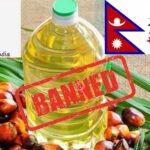Until the end of FY 074/75, Nepal was a zero export country for palm oil. The monthly macroeconomic indicators published by NRB showed the export was zero till Asadh 2075. Nepal first exported oil worth NPR 51 lakhs on Shrawan 2075. The figure increased to NPR 8.22 crores in Bhadra. Till the end of FY 2075/76, Nepal exported palm oil worth NPR 10.33 billion (10.33 Arba) which accounted for 10.6% of the total exports of Nepal. The trend continued and during the first 10 months of FY 2076/77, the country exported oil worth NPR 18.31 Arba. But then on May 2020 i.e. Baisakh 2077, the event took a swift turn when India started to create hurdles and barriers for the import of palm oil from Nepal in the customs. This stagnated the export of palm oil, between Baisakh 2077 and Asar 2077 the export amounted to a meager 70 lakhs. Despite the barriers in the last two months of FY 2076/77, palm oil had the largest share in exports i.e. 18.7% of total exports. The turn of events that took place in May 2020 is clearly seen in the export data for the FY 2077/78. In the first ten months of FY 2077/78 till Baisakh 2078, the export crashed to a mere 4 lakhs rupee.
Reason behind the rise and fall of palm oil export.
India is the biggest palm oil market in the world. In an attempt to support its soybean farmers and other domestic edible oil refiners, the govt. of India tried to curb the import of palm oil. Thus, it decided to tax palm oil heavily. In 2018, import duty on crude palm oil was increased from 30% to 44% and for refined palm oil; it went up from 40% to 54%. In the meantime, crude palm oil was subject to 10% import duty in Nepal.
India imposed only 6% tariffs on the import of refined palm oil from Nepal, as per the agreement on SAFTA. Lower tariff provided the edge to Nepali traders as import of refined palm oil from countries out of South Asia is subject to over 50 percent duty in India.
Nepali importers were importing crude palm oil from major palm oil producers like Indonesia and Malaysia. The imported palm oil was refined and packaged in Nepal before finding its way to India. These tariff differentials were the main reasons for the surge in the export of palm oil to India. Not innovation or entrepreneurial ingenuity triggered palm oil export. Around 30 billion Nepali rupees ($250 million) were invested to set up 19 refining units in Nepal to take the advantage of this tariff differential.
SAFTA’s rules of origin make it mandatory for Nepali exporters to add the value of at least 30 percent for imported goods before exporting them. Though the Nepali traders claimed that they added 32-33% value but the value addition always remained questionable. As the govt. of Nepal had given the power to issue Certificate of Origin to FNCCI and CNI, these bodies issued the Certificates stating that the value addition was as per the standard.
The government of India amended its foreign trade policy from ‘free’ to ‘restricted’ for refined palm oil trade in January 2020, further in an attempt to curb the import of refined palm oil it stated that the imports were affecting domestic refiners and local jobs. The Govt. of India also interpreted the rules of origin differently and barred the imports of palm oil from Nepal.
Though various reasons were given and the import of palm oil from Nepal was barred by the Indian authority, the major reason was the political differences between Nepal and India. In this short-lived (around 2 yrs) export of palm oil from Nepal, the Nepali traders capitalized on this arbitrage opportunity.
Way Forward:
The export of Soybean Oil from Nepal accounted for 33% of total export in the first ten months of the fiscal year 2077/78, and the sole importer is India, once again. Recently, The Indian authorities have shown serious concerns over the value addition in Soyabean Oil too. Would this also face a similar fate as palm oil?





